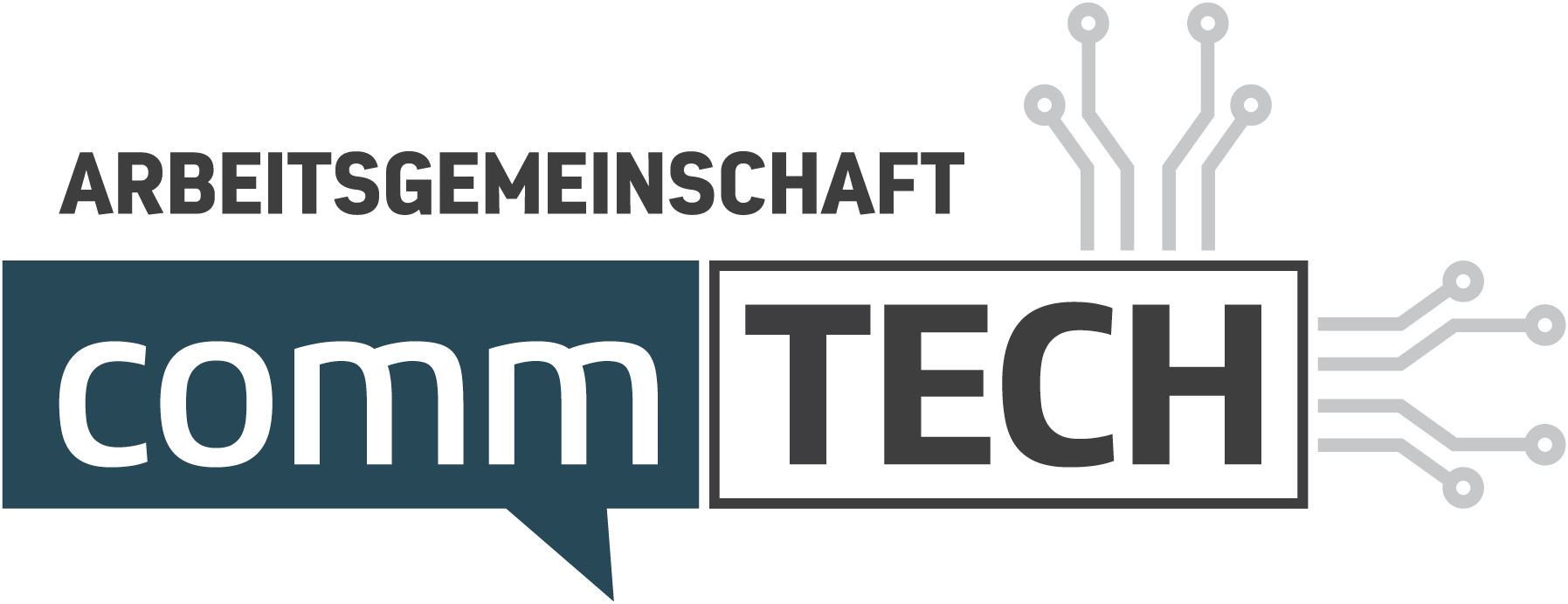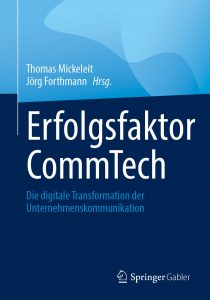- 31. July 2023
- Posted by: Thomas Mickeleit
- Category: NEWS
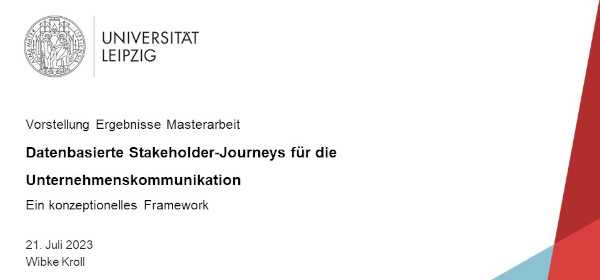
The age of dialogue in communication has begun

Data-based stakeholder journeys for corporate communications
A key idea of CommTech is the adaptation of the customer journey in the form of a stakeholder journey to corporate communications. Anyone who considers the idea will subsequently wonder in amazement why communications has so far failed across the board to maintain a continuous dialog with individual stakeholders beyond the “attention” stage, in which the “connectedness” stage is finally reached. Instead, the vast majority of communication functions are still continuously on the send button, no trace of dialog. In her master’s thesis, Wibke Kroll, a master’s student at the Chair of Strategic Communications Management at the University of Leipzig, developed a framework for data-based stakeholder journeys in corporate communications and thus did pioneering work. She recently presented the results of her work in an AG CommTech webinar. If you want to watch the performance (45 min), you can find it here. In addition, the slide deck is also available.
The starting point for the considerations is the need for personalized dialogic communication, which has become standard in marketing and is evidenced by the measurability of the value added contribution. What is right and demonstrably works for conversion to “loyal customer” via the attention, interest, impact and connectedness stages cannot be wrong for stakeholder conversion. What the stakeholder journey actually is, however, requires a definition, which Wibke Kroll offers us in this way:
The data-based stakeholder journey describes when and how the actor of a stakeholder group comes into contact with the corporate messages of the specific company or with the company itself on the basis of individual communicative touchpoints.
The touchpoints and the course of the journey are measured and analyzed on the basis of defined KPIs and individual data from internal and external information sources as part of a data processing process. In her model, Wibke Kroll distinguishes four stages, namely “(initial) contact,” “processing & evaluation,” “(inter)action,” and finally “cooperation.” The CommTech WG had based its model on the stages – as already introduced above – attention, interest, impact and connectedness.[1] There are good reasons for choosing well-considered designations for the stages of the stakeholder journey. In her work, Wibke tested the Stakeholder Journey for employees and journalists as an example and subjected this journey to a practical test with two focus groups consisting of communicators from internal and external corporate communications. In the focus groups, a strong sense of disturbance was articulated against the term “connectedness” because it might be met with strong disapproval, especially by journalists. In addition, “connectedness” is not the stated communication goal in all stakeholder journeys, and “connectedness” is presumably only achieved by going through the journey several times. The discussion about the correct terminology has once again been initiated by the master thesis and deserves attention. At the same time, it should be noted that despite all the different names for the stages [2], the mechanics always remain the same, namely to bring the stakeholder from one stage to the next via “call-to-actions” (CTAs) and to measure this conversion success.
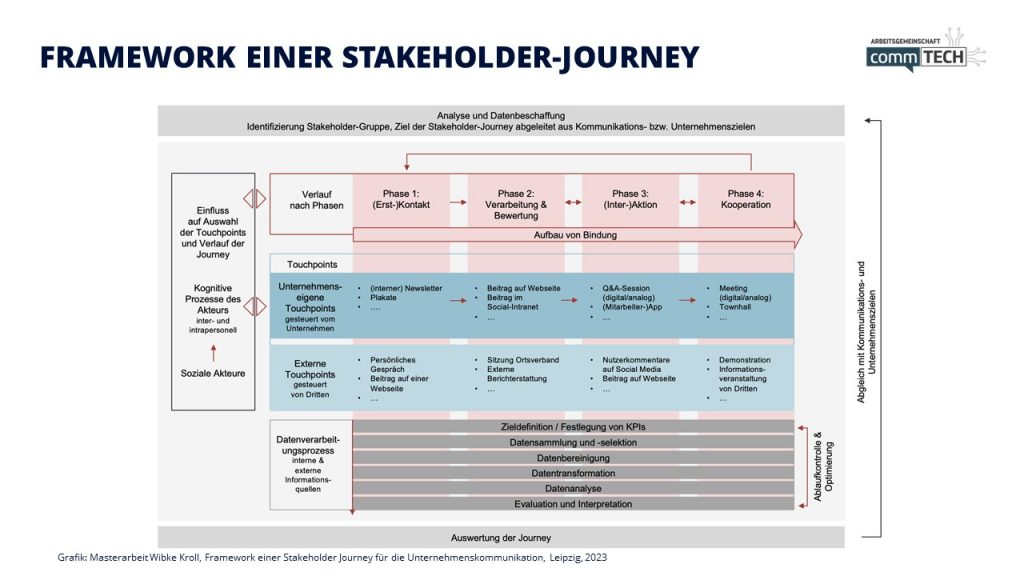
Correctly, the stakeholder journey starts with the development of personas, the relevant stakeholder personas, in order to get an exact picture of communication needs and preferred channels, among other things. At the same time, the communication objectives must be derived from the business objectives. From this it is already clear that the Stakeholder Journey is primarily applicable for the communication of large strategic topics or in campaigns. As a “thought model”, however, it can also be applied to the whole range of communication tasks, as Wibke Kroll pointed out in the focus group interviews with communication practitioners.
An important insight provides us with the finding that stakeholder journeys are not linear. So there can be loops; the Journey can be aborted and Journeys can have a different status depending on the topic. At the same time, a systematic evaluation of the collected data helps to take measures at an early stage that could, for example, prevent the journey from being interrupted.
Touchpoints are divided into the company’s own touchpoints and external touchpoints, which provide a different set of metrics to manage the journey and measure success via KPIs. Wibke Kroll pays special attention to the data processing process, which is lovingly differentiated in her model and reminds us that collecting data is not enough. Only actionable insights and subsequent actions deliver results.
The practical value of the master’s thesis results not least from the concrete recommendations for action that Wibke Kroll distilled from the work in the CommTech WG webinar and which can be read in Figure 2.
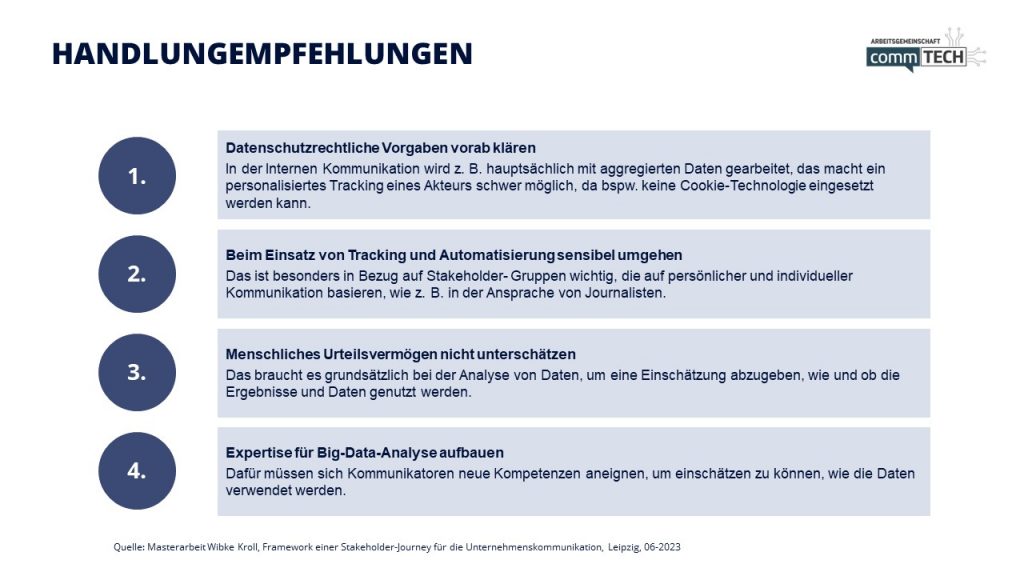
As a ceterum censio, point 4, building data literacy, should be noted. Communications functions will not be able to avoid this and, depending on the size of the department and its structure, will have to develop their “data literacy”, which sensibly defines who in the team should have which level of competence.
With her work, Wibke Kroll has perhaps provided an initial spark that can help communication catch up with the capabilities of marketing. In any case, a starting point is set. As Friedrich Dürrenmatt once said, “Once thought, it cannot be taken back.” [3]
Author
: Thomas Mickeleit
Thomas Mickeleit
is head of the CommTech AG, founder of KommunikationNeuDenken! and editor and author of the recently published reference book “Erfolgsfaktor CommTech: Die digitale Transformation der Unternehmenskommunikation”.
[1] Mickeleit et al, in Success Factor CommTech, The Digital Transformation of Corporate Communications, Springer-Gabler, 2023, pp. 69-96.
[2] GPRA also presented a model back in 2021 that distinguishes between the levels of attention, interest, impact, connectedness and advocacy. The Arthur Page Society distinguishes between Awareness, Interest, Impact and Support.
[3] Source: https://beruhmte-zitate.de/zitate/127144-friedrich-durrenmatt-was-einmal-gedacht-wurde-kann-nicht-mehr-zuruckge/
